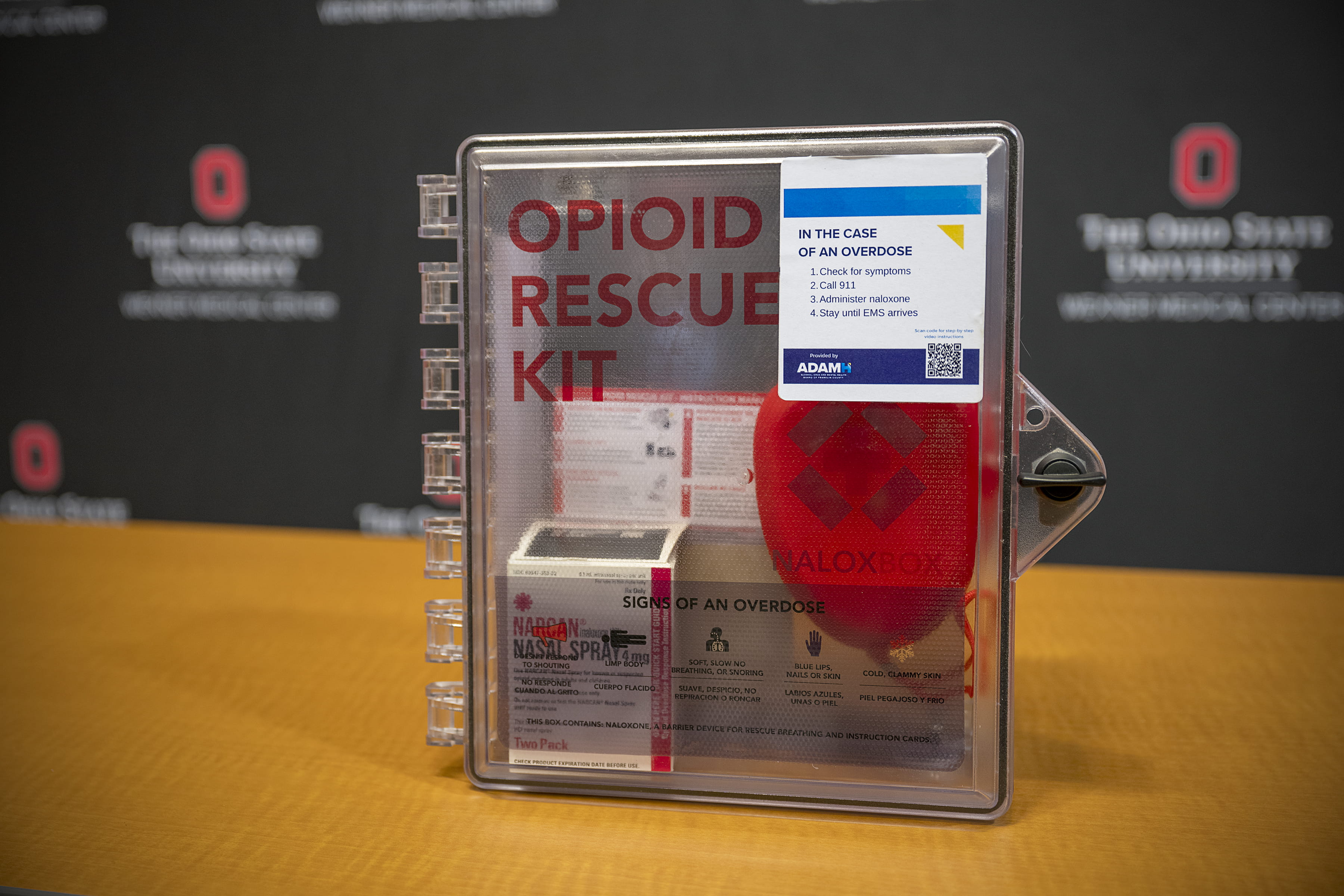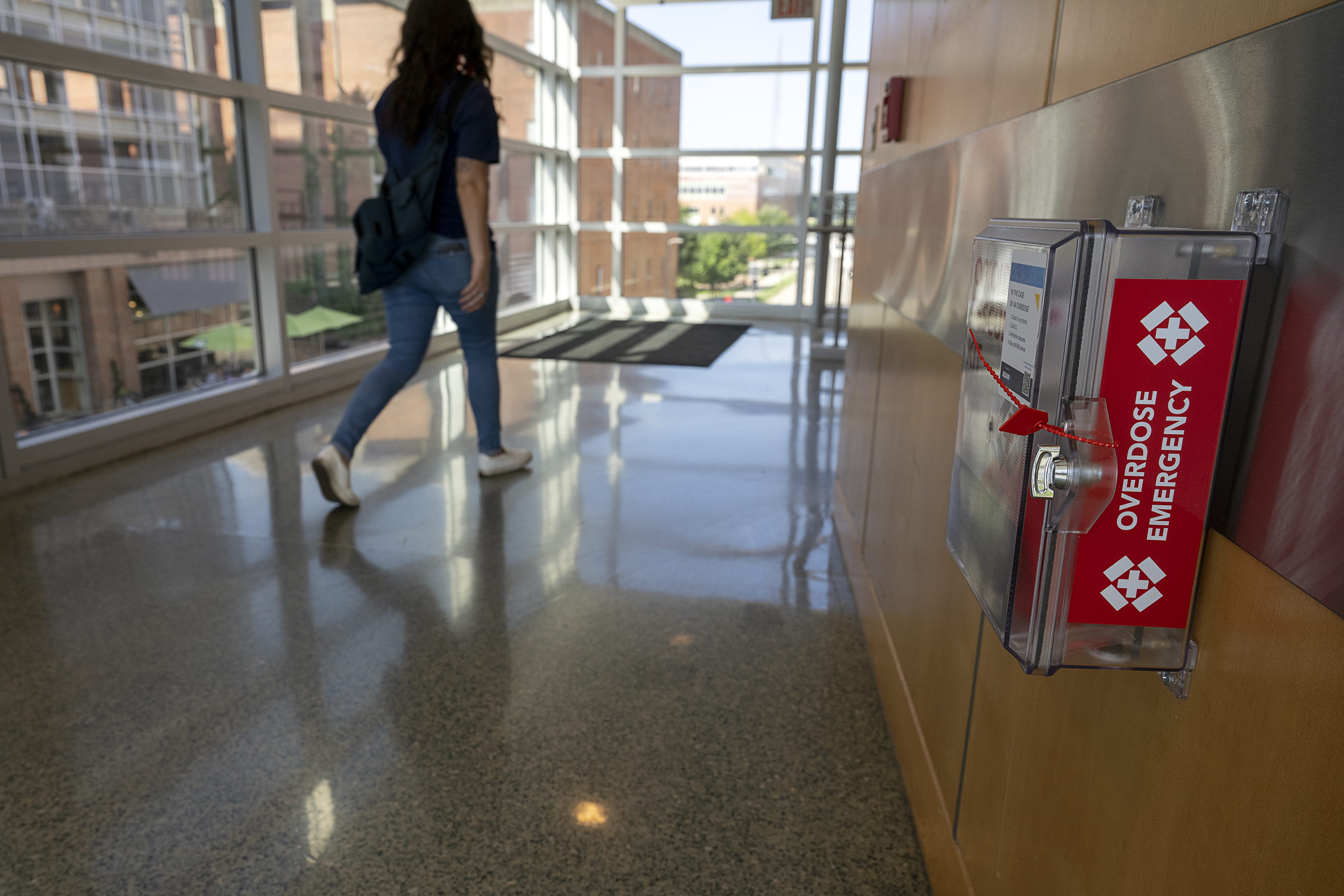August 28, 2023
COLUMBUS, Ohio – Naloxone, the lifesaving overdose reversal medication, is available for emergency public access at 28 locations across The Ohio State University campus and Wexner Medical Center through a collaboration with the Alcohol, Drug and Mental Health Board of Franklin County (ADAMH).
Ohio State is the newest community partner in ADAMH’s NaloxBox project that is increasing access to naloxone in public spaces across Franklin County. The program began in late 2021 in response to rising fentanyl overdose deaths. To date, 167 NaloxBox rescue kits have been installed across the community with plans for another 80 by year-end. Each kit contains two doses of naloxone in an easy-to-use nasal spray and instructions on it use.
“Many individuals in recovery from addiction are here today because they had another chance. Recovery is only possible if someone is still alive to take that step,” said Erika Clark Jones, CEO for ADAMH. “We are grateful for Ohio State’s partnership, which will help save lives by ensuring naloxone is easily available across the campus and medical center.”
 Naloxone is a medicine that rapidly reverses an opioid overdose and is easy to administer. Naloxone only works on overdoses caused by opioids. This family of drugs includes prescription painkillers like OxyContin, fentanyl, methadone and Vicodin, as well as illicit drugs like heroin. Naloxone will not reverse overdose resulting from non-opioid drugs, like cocaine, benzodiazepines (“benzos”) or alcohol.
Naloxone is a medicine that rapidly reverses an opioid overdose and is easy to administer. Naloxone only works on overdoses caused by opioids. This family of drugs includes prescription painkillers like OxyContin, fentanyl, methadone and Vicodin, as well as illicit drugs like heroin. Naloxone will not reverse overdose resulting from non-opioid drugs, like cocaine, benzodiazepines (“benzos”) or alcohol.Given how safe naloxone is, a victim of a non-opioid overdose or an overdose caused by a mixture of drugs will not be harmed by naloxone. In multiple drug overdoses (e.g., an opioid and a benzodiazepine) it is still worth administering naloxone as it will remove the effects of the opioid and may still reverse the overdose.
 "We are excited to partner with ADAMH to address the overdose crisis by making naloxone readily available in public areas at The Ohio State University campus, including the Wexner Medical Center. Overdoses are medical emergencies that can happen anywhere to anyone. We strongly believe that naloxone should be a standard emergency response tool everywhere to help save lives,” said Amanda Lucas, executive director of The Ohio State University Wexner Medical Center’s East, Harding and Dodd Rehabilitation hospitals.
"We are excited to partner with ADAMH to address the overdose crisis by making naloxone readily available in public areas at The Ohio State University campus, including the Wexner Medical Center. Overdoses are medical emergencies that can happen anywhere to anyone. We strongly believe that naloxone should be a standard emergency response tool everywhere to help save lives,” said Amanda Lucas, executive director of The Ohio State University Wexner Medical Center’s East, Harding and Dodd Rehabilitation hospitals.Ongoing maintenance of the boxes are provided through ADAMH agencies, CompDrug and Southeast Healthcare, while training is provided through Ohio State Wexner Medical Center. The project is funded through State Opioid and Stimulant Response dollars provided through the Ohio Department of Mental Health and Addiction Services. Other partner locations include Columbus Metropolitan Library branches, Columbus Recreation and Parks community centers, the Central Ohio Transit Authority (COTA), St. Stephen’s Community House and Community Housing Network-owned apartments.
Click here for a demonstration of how to administer naloxone by O. Trent Hall, DO, an addiction medicine physician at The Ohio State University Wexner Medical Center’s Department of Psychiatry and Behavioral Health.
# # #
Media Contacts: Eileen Scahill, Wexner Medical Center, 614-354-9660; Eileen.Scahill@osumc.edu
Shelly Hoffman, ADAMH, 614-571-6826; shoffman@adamhfranklin.org
